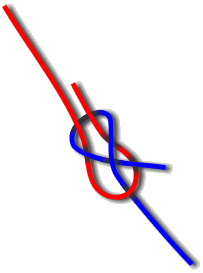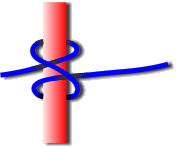Nodi

|
Difficoltà: |
    
|
|
Tempo: |
    
|
|
Costo: |
    
|
|
Nodi |

|
||||||
|
|
|||||||
|
|||||||



|
01/01/2001 |
|
|
Ognuno di noi conosce almeno due nodi: il nodo semplice ed il nodo piano ganciato due volte (si tratta del fiocco delle scarpe). Esistono però delle circostanze in cui può
essere utile conoscere qualche altro nodo. Everybody knows two knots at least: Overhand knot and square knot (is the one we use for the shoes). But the knowledge of some more knots can be helpful in some common activities (fishing, sailing, climbing, scouting etc.) |
|
Come premessa occorre dire due cosine: le corde che vengono utilizzate possono essere in
fibra vegetale (cotone, canapa, manilla ...) o in
fibra sintetica (poliammide, poliestere, polietilene, polipropilene ...). Per quanto riguarda la loro fattura possono essere ritorte o trecciate.
A short introduction on the different kinds of cords: ropes, made by vegetal fibre, and synthetic fibre (polyamide, polyester, polyethylene, polypropylene etc.). The fibre are then
ritorto o trecciato
To tighten knots, pull the two ends of the rope (corrente e dormiente), but often you will need to use your hands to model the shape of the knot.
|
|
 |
Gassa d'amante BOWLINE |
|
Nodo di scotta o a bandiera SHEET BEND |
 |
|
|
|
 |
Nodo inglese o nodo del pescatore Inglese |
|
Nodo parlato CLOVE HITCH |
 |
 |
Nodo a serraglio CONSTRICTOR HITCH |
|
Legatura incrociata Inglese |
 |
 |
Nodo margherita SHEEPSHANK |
|
Nodo d'arco degli eschimesi (o nodo di Bulin) FISHERMANíS EYE |
 |
 |
Gruppo d'ancorotto FISHERMANíS BEND |
|
Impalmatura semplice |
|
|
WHIPPING |
|
|
Se vuoi portare con te i nodi, puoi scaricare la
versione |
|
|
When you decide to use a knot, always make some tests to verify if it is suitable for the goal. In the bibliography you will find some references. |
|



|
01/01/2001 |